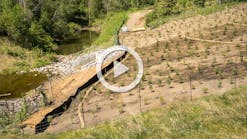In the spring of 2000, a project along the Mühlheim, Germany, Mendenerstrasse stabilized a slope experiencing rockfall and superficial slidings. Located alongside the Ruhr River at the foot of the Kahlenberg, the rock and soil slope was approximately 445 m long and 12 m high at its highest point. To stabilize the surface, high-tensile steel wire mesh was used in combination with nailing. The slope was also revegetated.When the road above the bank of the Ruhr and along the foot of the slope was built, the natural terrain was cut at a very steep angle. The rocky face (sandstone, silt, and clay stone) was laid bare over a length of approximately 445 m. The cut slope is 8-12 m high and inclined by 55-75° . Above the cut edge the terrain flattens, and scree and colluvium cover the rocky slope.Rock breakouts and superficial slidings occurred several times in January and February 1999, causing the Mendenerstrasse to be closed to road traffic for safety reasons. Many trees standing at an angle or growing in a bow, as well as cracks several centimeters wide in the footpath above the edge of the slope, indicated that a creeping deformation of the soil layer was in progress. Based on the geological situation, however, the overall stability of the slope was not endangered.The rock and soil slope was cleared, cleaned, and secured by means of a mesh cover in combination with nailing. Excessively steep areas of soil were cut and levelled. The Tecco mesh, developed by Fatzer AG, Geobrugg Protection Systems of Romanshorn, Switzerland, was held in position with spike plates and nailing. Tightening the GEWI nuts presses the system’s spike plates and the mesh onto or slightly into the subsoil at a defined force, stretching it and preventing deformations in the subsoil, slidings, and breakouts.
Because of the high-tensile mesh and the optimal interaction between the mesh and the system spike plates, it was possible to select horizontal and vertical distances between nails of 2.5 m (in the steeper section of the cutting), up to a maximum distance of 3.3 m (in the upper, flatter section). GEWI-type nails 28 mm in diameter were used for the nailing. The average nail length was 4 m.The Tecco mesh has a three-dimensional structure and is made from a high-tensile steel wire; tensile strength of the individual wires is more than 1,770 newtons (N)/mm2. The size of the individual mesh is 83 x 143 mm. The wire has a diameter of 3 mm and features an aluminium-zinc coating. The tensile strength of the mesh is at least 150 kN/m in longitudinally and at least 75 kN/m transversely. Compared with conventional wire meshes offering a tensile strength in longitudinal direction of approximately 50 kN/m, the Tecco mesh of similar mesh size and wire diameter can absorb substantially higher forces and pass them on to the subsoil via the nailing. Therefore, subject to the local situation, larger distances between the nails become possible. In many cases the wire mesh is an economical alternative to wire-rope nets. In addition, the nail pattern is freely selectable if a mesh cover is used, making the system adaptable to the local circumstances. The Tecco surface stabilization system (mesh, system spike plates, and nailing) is dimensioned on the basis of the RUVOLUM concept developed by Rüegger Systeme AG in St. Gallen, Switzerland. Instabilities near the surface and parallel to the slope, as well as local instabilities between individual nails, are investigated. Load-bearing resistances of the mesh against selective tensile strains parallel to the slope and against shearing at the edge of the spike plate are compared to the maximum possible strain, taking the corresponding safety factors into account. For the Mendenerstrasse slope project, the load-bearing resistances were determined under the leadership of the Landesgewerbeanstalt Bayern in Nuremberg, Germany, using test equipment developed especially for the purpose.





